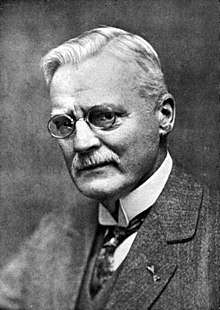Gerrit Grijns
| Gerrit Grijns | |
|---|---|
 Gerrit Grijns | |
| Born |
28 May 1865 Leerdam, the Netherlands |
| Died |
11 November 1944 (aged 79) Utrecht, the Netherlands |
| Nationality | Dutch |
| Known for | Beriberi, Vitamins |
| Scientific career | |
| Fields | Physiology |
Gerrit Grijns (May 28, 1865 – November 11, 1944), was a Dutch researcher and co-discoverer of vitamin B1 (thiamine) as the successor to the later Nobel Prize winner Christiaan Eijkman .
It was Eijkman who in the former Dutch East Indies was the first to associate the deficiency disease beriberi with the lack of the outer membrane in machine-peeled rice. Eijkman fell ill and returned to Europe. His successor Grijns believed that the membrane contains a substance that is indispensable for a healthy metabolism. By writing of "partial hunger" and "protective substance" in 1901, Grijns anticipated the concept of vitamins.[1][2]
In 1917 Grijns had to leave the Dutch East Indies for health reasons. After returning to the Netherlands, Grijns became professor of animal physiology at Wageningen University in 1921, where he taught and conducted research until 1935. From 1929-1930 he was Rector Magnificus of the Landbouwhogeschool Wageningen.
On 28 May 1924, Grijns became a member of the Royal Netherlands Academy of Arts and Sciences. Grijns was nominated in 1926 and 1927 for the Nobel Prize for medicine together with Eijkman. When Eijkman (and Frederick Hopkins) received the prize in 1929, Grijns was passed over.[3]
Notes
- ↑ Grijns, G. (1901). "Over polyneuritis gallinarum". Geneeskundig Tijdschrift voor Nederlandsch-Indie. 43: 3–110.
- ↑ Gratzer, Walter (2006) [2005]. Terrors of the Table: The Curious History of Nutrition. Oxford University Press. p. 140. ISBN 0199205639.
- ↑ Carpenter, Kenneth J. (2004). "The Nobel Prize and the Discovery of Vitamins". Nobel Media AB. Retrieved April 27, 2018.
External links
- Gerrit Grijns: (May 28, 1865 — November 11, 1944) - Journal of Nutrition